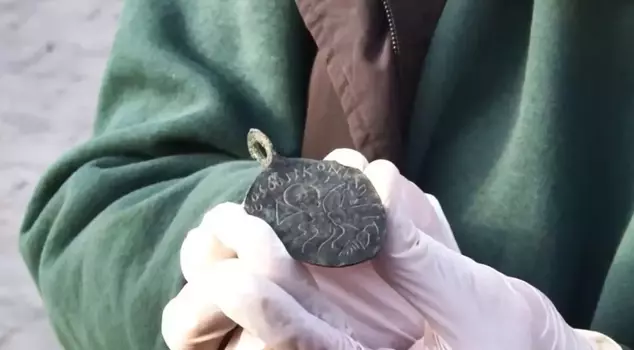
12.11.2024 19:02
In the excavations conducted at the ancient city of Hadrianopolis, which was used as a settlement during the Late Chalcolithic, Roman, and Early Byzantine periods, a pendant depicting Prophet Solomon, approximately 1600 years old, was uncovered.
Excavation and restoration works are ongoing under the leadership of Assoc. Prof. Dr. Ersin Çelikbaş from the Department of Archaeology at Karabük University as part of the "Heritage for the Future Project" in the ancient city of Hadrianopolis, located in the Eskipazar district of Karabük.
In the ancient city, famous for its mosaics depicting many animals on the church floors and thus referred to as "the Zeugma of the Black Sea," structures such as two baths, two churches, a defensive structure, rock tombs, a theater, an arched and domed building, a monumental cult niche (recess in the wall), walls, villas, other monumental buildings, and some cult (sacred) areas have been found so far.
Recently, a pendant used as an amulet depicting Prophet Solomon dating back to the 5th century AD was discovered during the excavations.
"SIMILAR EXAMPLES HAVE NEVER BEEN ENCOUNTERED IN THIS GEOGRAPHY BEFORE"
Assoc. Prof. Dr. Ersin Çelikbaş told reporters that they are continuing their work in the ancient city as part of the "Heritage for the Future Project" of the Ministry of Culture and Tourism.
Stating that significant findings have emerged during these studies, Çelikbaş said, "We uncovered one of these this week during the excavations carried out in the structure we named 'SDJ-3.' We believe it is an important artifact for Anatolian archaeology. Because similar examples have never been encountered in this geography before. So what is this artifact? It is actually a pendant used as an amulet." he stated.
"PROPHET SOLOMON IS DEPICTED SPEARING THE DEVIL"
Çelikbaş noted that one of the important aspects of this object is the inscriptions on both sides and the depiction on it, stating: "In the depiction, Prophet Solomon is shown spearing the devil with a spear while riding a horse. So why is there such a depiction? Because Prophet Solomon is important in all three monotheistic religions. He is mentioned as a ruler in Judaism and the Bible, while in Islam, he is mentioned as a prophet alongside his kingship. Therefore, the depiction of Prophet Solomon, who is significant for the celestial religions, on this pendant truly surprised us and also showed us that it is an important artifact for Anatolian archaeology."
Çelikbaş explained that the inscription on the pendant reads, "Our Lord has defeated evil," and said, "So why was this pendant, this amulet found here? Actually, the military nature of the ancient city of Hadrianopolis has an effect on this. What is it? We had previously identified the existence of a cavalry unit in Hadrianopolis through archaeological excavations with concrete data." he stated.
"IT TALKS ABOUT PROPHET SOLOMON AND OUR LORD DEFEATING EVIL"
Çelikbaş pointed out that Prophet Solomon's interest and attachment to horses is also known, and he said:
"It is also known that Prophet Solomon was the commander of the armies. Therefore, we understand that the cavalrymen of the Roman and post-Roman, Byzantine periods in Hadrianopolis were also depicted here as protectors. Of course, we know that Prophet Solomon was endowed with knowledge and wisdom in both Islam and pre-Islamic religions, and that our Lord granted him knowledge and wisdom. We still see that various judgments and decisions known as Prophet Solomon's rulings are effectively used as idioms among people today."
Emphasizing the significance of the artifact, Çelikbaş said, "On the front side, it talks about Prophet Solomon and our Lord defeating evil. On the back side, the names of our four holy angels are present. Azrael, Gabriel, Michael, and Israfil. This is also very important. To date, no similar example of this artifact has been found in Anatolian archaeology." he stated.
"A SIMILAR EXAMPLE IN TERMS OF DEPICTION HAS BEEN FOUND IN JERUSALEM, THE CAPITAL OF PALESTINE"
Çelikbaş noted: "A similar example in terms of depiction has been found in Jerusalem, the capital of Palestine. The emergence of two similar artifacts over such long distances indicates that this place was also an important religious center in ancient times. According to the font of the inscriptions on our artifact and the stratigraphic data we obtained from our studies, it is dated to the 5th century AD."